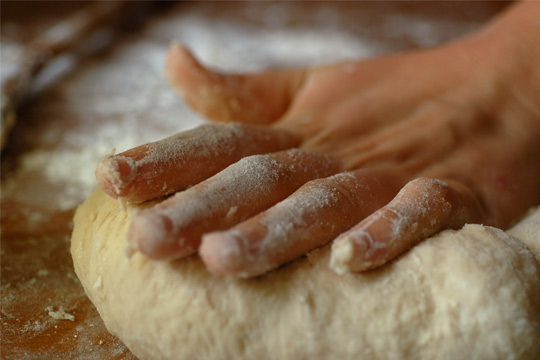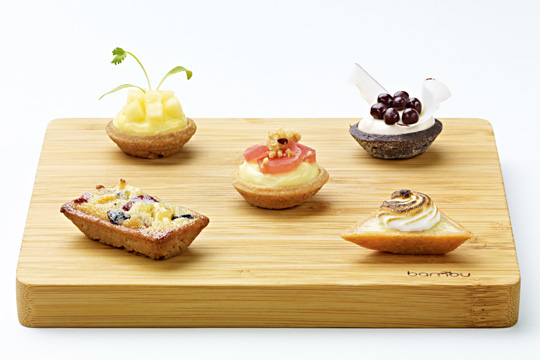
Reducing Food Waste in Foodservice
October 16, 2018 by Doreen Garelick, Dietetic Intern
Our intern Doreen attended a food waste summit for restaurants and compiled these tips to help food service operators redirect…
Behind the Scenes, Where to find SPE-certified
May 9, 2013

Image via sweetbeetandgreenbean
Dietetic Intern Tim Chin gives us a glimpse of what life is like in the pastry kitchen at Michelin-starred Rouge Tomate.
For the past two months or so, I have been spending two days a week cooking as an intern in the pastry kitchen at Rouge Tomate. The cozy space serves as a backdrop for dozens of daily tasks both menial and messy, accomplished by hands caked with flour and tacky with syrup, weary from whisking. Each day begins and ends with production – the preparation of products to be implemented in finished plated desserts. Typical duties include mixing tart dough, cooking curds, setting fluid gels or breaking down several pounds of fruits and vegetables to be cooked, poached, juiced or infused. In between, there are two rounds of service: lunch and dinner. Line cooks prepare plated desserts á la minute, deftly juggling up to five orders at a time and plating with both precision and speed.
I have since graduated from rolling hundreds of 11-gram balls of apricot cookie dough and begun to work the line in spurts. I plate some portion of desserts during dinner service in between production tasks. Now, before going any further, I must admit that I am by no means a pastry “chef” – or even a pastry “cook” – despite seven months of training at a reputable pastry school. In my opinion, such titles require months to years of suffering, perseverance and spooning quenelles. But I do have a backbone. That the kitchen would place any faith in my ability to “work the line” is a testament either to my bull-like toughness or – more likely – reckless determination.
But I’ve learned a couple things. I have been reminded of what it takes to make good food, and most importantly developed an appreciation for its conception and creation.
Working the line is an exercise in ultra-multitasking and sheer willpower. The lifeline of the station cook – the crutch upon which the entire service and even career rest – is mise en place : the preparation, arrangement and organization of ingredients required for service in plated courses. With proper mise en place a cook is a well-‐functioning, well-‐oiled machine. Without it, he or she is – as one of my mentors puts it – “in the weeds, destined for failure.”
After mise en place, it is all up to the cook to deliver the goods. The expediter (typically the sous chef or head chef when he is available) calls out orders, and the cook must have the good sense and skills to fulfill those orders. Plates fly in, food goes on the plates, plates go in the “window”, and plates fly out.
To get a better sense of service, let’s look at one plated dessert in particular:

The seasonal miniature tartelette plate (at the time of writing, now phased out of production) consists of six elements: a lemon tartelette, a coconut tartelette, a chocolate-hazelnut tartelette, a pistachio-orange cream tartelette, a walnut mini-‐pie and palpable frustration. Artfully arranged, these are five delicious morsels of confectionary goodness. Keep in mind that Rouge Tomate has made good on the promise of miniature: the treats are fit for the delicate hands of children – or better yet, Smurfs – but with all the fancy flavor sensibilities of an adult palate. The result is a blissfully sublime experience for the customer, and a conceivably difficult one for the line cook. But let’s not get ahead of ourselves.
The dessert begins with cleaning the station of any visible extraneous debris. Then the cook procures a clean wooden board. He or she arranges a semolina tart shell, a coconut-lime shell (both of which are triangular and identical in color), one round pistachio shell, and one round chocolate shell on a cutting board. Hopefully, these shells have been mixed and blind baked prior to service. Then the cook selects one pre‐baked walnut pie on a separate plate to be heated in the oven. Next comes the piping: lemon curd for the semolina shell; coconut pudding for the coconut‐lime shell, orange cream filling for the pistachio shell and hazelnut pudding for the chocolate shell. After piping, the cook squares off the sides of all triangular tarts so that the fillings are even and clean. Often the corners of these tarts break from the pressure of squaring, forcing the cook to start over.
Then come the garnishes. The lemon tart is garnished with grapefruit pulp and a sprig of micro basil – not too large, not too small, and never too “stemmy”. The coconut tart gets a sprightly helping of passion fruit seeds and a sprig of micro-‐cilantro in the corner. The orange‐pistachio tart receives one mini-segment of clementine, one pomegranate aril, one half of a Sicilian pistachio, and one thin segment of confit orange peel. The chocolate-hazelnut tart needs a sprinkle of Maldon salt on top, and is finished with a brûléed banana slice.
Not out of the weeds yet. Somewhere amidst this dance, the cook must not neglect the walnut pie. It must be heated so as to be hot but not burned, sometime between the placement of orange peel and the torching of sliced banana. Once out of the oven, the cook pipes a delicate line of 0% Greek yogurt, places a dried date ball in the middle, and sprinkles with Maldon salt.
The tarts are set carefully on the wooden serving board. The board is wiped, placed in the window, and the dessert is ready for eating. The cook wipes down the station of debris and continues about his or her business.
I count roughly seventeen steps in the assembly of a dessert that typically goes out in the span of five to six minutes. Why subject oneself to such microscopic and potentially infuriating handiwork? For the cooks and career-‐minded among us, the short answer is that we are masochists, eager for challenge and the inevitable exigencies of the culinary industry. The more acceptable answer may be that we don’t view the microcosmic plating of tartelettes as microcosmic or exasperating at all, but rather part of a greater, holistic approach to cooking in which every movement flows seamlessly under intense mindfulness and concentration. Plating a dessert then does not appear as a jumble of disparate elements and procedures because in short, we love and enjoy the process of making food.
But in stepping back, I garner a greater appreciation for what goes into my food.
I’ll be following up on this post next week with a piece on what my experience in the kitchen has taught me about mindful eating, considering all of the complexities and hard work that goes into its preparation.
Read part 2 of Tim's blog post here.

October 16, 2018 by Doreen Garelick, Dietetic Intern
Our intern Doreen attended a food waste summit for restaurants and compiled these tips to help food service operators redirect food waste from landfills.
Nutrition 101

Nutrition 101
September 26, 2018 by Doreen Garelick, Dietetic Intern
Ever notice headlines about rapid weightloss? Dietetic Intern Doreen Garelick looks deeper into a recent eye-catching headline to see if there's any truth behind it.
Connect
 Follow us on Twitter
Follow us on Twitter Friend us on Facebook
Friend us on Facebook Follow us on Pinterest
Follow us on Pinterest Follow us on Instagram
Follow us on Instagram Read our Blog
Read our Blog Watch videos on YouTube
Watch videos on YouTube Watch videos on Vimeo
Watch videos on Vimeo Connect with us on Linkedin
Connect with us on Linkedin Find us on Foursquare
Find us on Foursquare
Tweets by @SPEcertifiedBlog Search
Categories
SPE Certified Newsletter
Sign up for news on the latest SPE-certified venues, events and SPE updates.
We will never share your personal information with a third party.